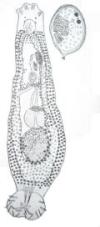| Back to Back Issues Page |
 |
|
The Goldfish Gazette, Issue #007 -- Raising Goldfish Fry July 31, 2014 |
Goldfish Care Tips and GuidelinesA Free Monthly Resource For Goldfish Enthusiasts In this issue It's too early for the Southern hemisphere, but most Northern hemisphere goldfish enthusiasts should be well into raising their spring spawns by now. Raising Goldfish Fry
How successful have you been at raising this year’s spawning, or did all the fry suddenly die off? There can be two reasons for this; an ammonia spike in their water, usually caused by overfeeding combined with a lack of water changes...or parasites. I received a timely email from an Australian enthusiast last week who informed me that his goldfish had just spawned in their aquarium and he wanted to try and raise some fry. I mentioned it was very early for goldfish to be spawning at this time of year in Australia but he explained that his house was centrally heated and rarely dropped below 68 degrees (20oC). We have all had this happen and unfortunately it isn't an ideal situation for raising fry because from the outset, the most important factor of cleanliness is already compromised. By cleanliness I don't just mean a clean aquarium with clear water. I am also talking about diseases and parasites that can be present in an aquarium full of healthy adults. If fry are exposed to these diseases they can be wiped out in days. Parasites are a problem for goldfish under 2” (52mm) in body length. There are two types, body flukes and gill flukes. They are very small, white, and very hard to see. Gill flukes can be seen on fry as a small white beard that moves. The fry tend to stay near the surface. Body flukes are harder to see. The fry can be seen twitching as they try and dislodge the flukes. The usual source of flukes is from the parents. Two ways to prevent contamination are to treat the parents before breeding or remove the eggs from the breeding container. The safest option is to do both, as a 100% success rate removing all parasites from the parents is unlikely. Treatment of fry under a month old is difficult as the treatment level needed to kill the flukes kills the fry. If you suspect your fry have flukes and they are under a month old, you need to spread them out as widely as possible, and feed them heavily. To help with this, if you haven’t culled them yet and they are around two weeks old, they can be culled for single tails if twin caudal fins are the standard. There is no point keeping inferior fry that take up valuable space. Newly hatched mosquito wrigglers are the best food if you can get them as they can double the growth rate of fry. An ideal filter in these situations is a diatom powder filter that has the ability to filter down to micron level. This level of filtration filters out parasites. Once the fry are a month old, there are several options for treatment such as fluke tablets. Follow the instructions that come with the tablets and start with half the dose first with a few fry. Monitor the fry for at least half a day before treating the rest of the fry. My methodology would be if the test doesn’t kill the fry in the test group after half a day, use that dosage for the rest of the fry, and increase the dosage to the test group closer to full strength. This will give all the fry some level of treatment and allows you to keep testing what strength treatment the fry will cope with. You need to act quickly because if you notice fry are dying in numbers, you will probably only be able to save a few fry. Flukes slow down or stop fry growth, so if your fry don’t appear to be growing at the pace they should be, suspect flukes. The fry never really catch up, but the quicker they are dealt with the less impact they have on fry development.
Always assume new purchases have flukes and give them a dose of fluke tablets. The usual quarantine method of a mild salt bath for two weeks won’t get rid of any flukes they may be carrying. To read more about raising goldfish fry click here... To read more about goldfish fluke treatments click here... Comments? Ideas? Feedback? I'd love to hear from you. Just reply to this e-zine and tell me what you think, or what topics you want covered. Next Month’s Topic Goldfish standards: what makes a champion goldfish? |
| Back to Back Issues Page |